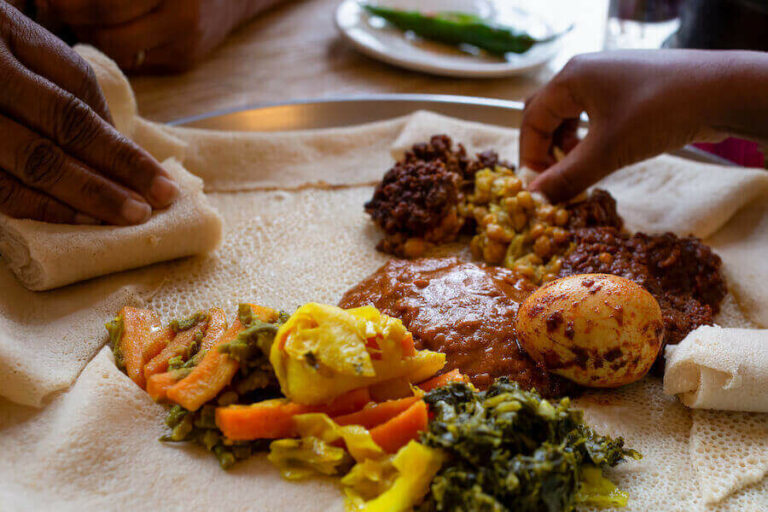Introduction to Injera
Injera is a sourdough flatbread that is a staple in Eritrean cuisine. It is made with teff flour, water, and a sourdough starter, which gives it a tangy flavor and spongy texture. Injera is usually eaten with stews or vegetables, and is used as a utensil to scoop up the food.
History of Injera in Eritrean Cuisine
Injera has been a part of Eritrean cuisine for centuries. It is believed to have originated in Ethiopia, which has a similar version of the bread. Injera was introduced to Eritrea by Ethiopian immigrants, and has since become an integral part of the country’s food culture. It is a symbol of hospitality and is often served to guests.
Ingredients and Preparation of Injera
The main ingredient in injera is teff flour, which is a gluten-free grain that is native to Ethiopia and Eritrea. The teff flour is mixed with water and a sourdough starter, which is made from fermented teff flour and water. The mixture is left to ferment for a few days, which gives the bread its characteristic tangy flavor and spongy texture. The batter is then poured onto a hot griddle or clay pan, where it cooks for a few minutes until it is bubbly and cooked through.
Importance of Injera in Eritrean Dining
Injera is an important part of Eritrean dining. It is often served as the base of a meal, with stews or vegetables piled on top. Injera is also used as a utensil to scoop up the food. This communal way of eating is an important part of Eritrean culture, and injera is a symbol of sharing and togetherness.
Injera as a Staple in Traditional Eritrean Dishes
Injera is used in many traditional Eritrean dishes, such as tsebhi (stew), zigni (spicy beef stew), and shiro (ground chickpeas or lentils). These dishes are often served with injera and eaten with the hands. Injera is also used as a wrap for meat, vegetables, and lentils, creating a portable meal that can be eaten on the go.
Health Benefits of Injera
Teff flour, the main ingredient in injera, is rich in nutrients such as iron, calcium, and protein. It is also gluten-free, which makes it an ideal choice for people with gluten sensitivities or celiac disease. The fermentation process used to make injera also increases the bioavailability of nutrients in the teff flour, making it more easily absorbed by the body.
Variations of Injera in Eritrean Cuisine
There are many variations of injera in Eritrean cuisine. Some are made with a mixture of teff and wheat flour, which gives them a milder flavor. Others are made with different grains, such as barley or sorghum. Some injera are thicker and spongier, while others are thinner and more crepe-like. These variations add to the diversity of Eritrean cuisine and allow for different flavor and texture combinations.
Conclusion: Injera’s Role in Eritrean Culture and Cuisine
Injera is more than just a bread in Eritrean culture. It is a symbol of hospitality, sharing, and togetherness. It is an integral part of traditional Eritrean dishes, and is used in a communal way of eating that brings people together. Injera’s unique flavor, texture, and nutrition make it a beloved staple in Eritrean cuisine, and a cultural icon that has stood the test of time.

